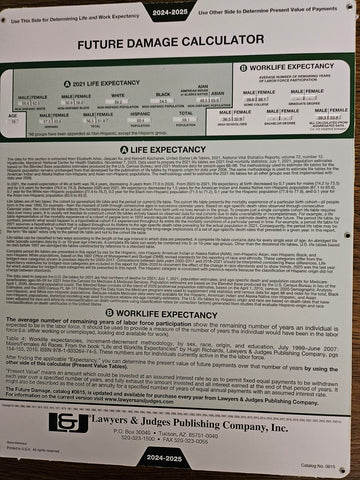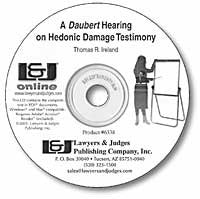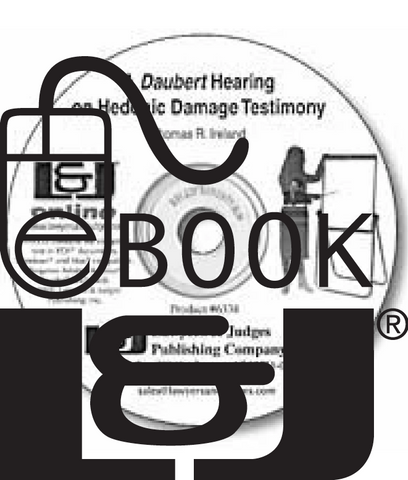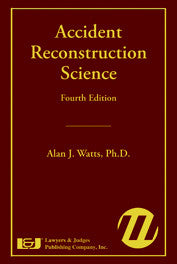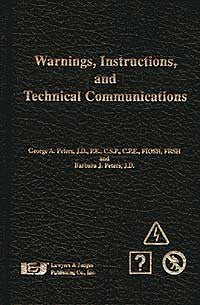
Warnings, Instructions and Technical Communications
- Author: George A. Peters, Barbara J. Peters
- ISBN-10: 0913875619
- ISBN 13: 978-0913875612
- Copyright Date Ed: February 2, 1999
- Pages: 450 pages
- Binding Information: Casebound
-
Size: 6 ✕ 9 Inches (US)
The first comprehensive book on warnings.
This text provides immediately useful information for design engineers, lawyers, professors and hazard communication specialists.
Failure to warn and provide appropriate safety information is often alleged in product liability lawsuits, toxic tort claims, and ethical drug cases. Some allegations and supporting proof seem simple, but failure-to-warn cases can easily become complex. The counsel who proceeds on basic common sense and a case-law approach can be unpleasantly surprised, especially when expert testimony and legal arguments are not effectively rebutted because the counsel considered warning issues elemental.
When you have consulted Warnings, Instructions, and Technical Communications, you will be prepared to encounter the most complex situations. You will learn how warnings are distinctive from product defects or deficiencies, and how the analysis of warnings or their absence differs from accident reconstruction.
This book is also available as an eBook. Click here to purchase and download:
TOPICS INCLUDE
- Advertising and warnings
- Alarms Behavioral influences
- Cautions
- Chemical labeling
- Cost of failure to warn
- Design criteria
- Legal concepts
- Material safety data sheets
- Miscommunication
- Preventive remedies
- Railroad crossings
- Standards
- Technical communication
- Testing and evaluation
- Workplace hazardous substances
Table of Contents
Preface
Acknowledgments
Chapter 1: Introduction to Warnings
1.1 Introduction
1.2 Fundamental Questions in Failure to Warn
A. What is the basic objective of the warning?
B. Does the warning deal with residual risk?
C. What are the psychological costs to those exposed?
D. Is the warning appropriately supplemented?
E. Has the warning been formulated in a rational, systematic manner?
1.3 The Effectiveness of Warnings
1.4 Standards
1.5 Expectations
1.6 Risks
1.7 The Importance of Warnings
1.8 Illustrative Vehicle Warnings
A. Vehicle turn signals
B. Reverse warnings
C. Brake warnings
1.9 Actual Use of Warnings
1.10 The Cost of Failure to Warn
References
Chapter 2: Basic Concepts
2.1 Introduction
2.2 Case Examples
2.3 Legal Concepts (Typical Jury Instructions)
A. General
B. Specific
C. Duty of a manufacturer
D. Supplier's duty
E. Duty of a component part maker
2.4 Preventive Remedies
2.5 Discussion Questions
2.6 Commentary
2.7 Perspective
2.8 Additional Principles and References
A. Early application of warning principles
B. Warnings and industrial hygiene programs
C. Warnings and quality assurance
D. Post-sale duty to warn
E. Highway warning signs
F. Other sources of information
1. Books and periodicals
2. Professional associations
3. Standards
4. Instructions
G. Case law
1. Judicial quotations of the law
2. Recent warning cases
2.9 Actual Railroad Warnings
2.10 Current Warning Problems
2.11 Reduction of Necessary Warnings
2.12 Mandatory Warnings
2.13 Questions
2.14 Postscript
Chapter 3: Instructions and Directions
3.1 Introduction
3.2 Automotive Vehicles
A. Warnings
B. Service manuals
C. Owner's manuals
3.3 Directions and Procedures
3.4 Material Safety Data Sheets
3.5 Notices
A. Apartment residents
B. Lease and sales documents
3.6 Effects of Other Warnings
3.7 Construction Sites
3.8 Risk Information
A. Italy
B. The Netherlands (Failure to Inform)
C. France (No Information)
D. United Kingdom (Risk Assessment Information)
E. Further information
3.9 Chemical Labeling
3.10 Environmental Notices
A. Material
B. Conformance
3.11 Workplace Hazardous Substances
A. International standards
1. Workplace labels
2. Classification of hazardous substances
B. Australian practices
C. Chemical information sources
3.12 Derivative Legal Issues
A. Basic philosophy
B. Legal duty
1. Standard of care
2. Delegation of duty
3. Intervening conduct
4. Compliance with standards
C. Personal inquiry
3.13 Graphic Instructions and Directions
3.14 Questions
References
Chapter 4: Technical Communications
4.1 Introduction
4.2 Liability Prevention
4.3 Examples of Miscommunication
4.4 Systems Perspective
4.5 Testing for Literacy Level
4.6 Self-Test Questions
A. Owner's manuals
B. Communication of recalls
C. Immunities and warnings
D. Disclosure of dangers
E. Industrial chemicals
F. Medical devices
G. Construction conflicts
H. Safe havens
I. Compliance alone
J. Railroad workers
K. Human research
References
Chapter 5: Alarms
5.1 Introduction
5.2 Backup Alarms
A. Audible
B. Patents (state-of-the-art)
C. Visual
D. Early requirements
E. Discriminating alarms
F. Alarms versus printed warnings
5.3 Tilt Alarms
A. Work platforms
B. Scissor lifts
C. Stability
D. Warning devices
E. Design life
F. Assigned responsibilities
G. Code requirements
H. Design objectives
I. Crane stability devices
5.4 Collision Avoidance Systems
5.5 Railroad Crossing Alarms
5.6 Perspective
5.7 Other Alarms
5.8 Alarm Systems
5.9 Questions
References
Chapter 6: Recalls
6.1 Introduction
6.2 Techniques
A. Notice by press release and mail
B. Home visits
C. Manual inserts
6.3 Form
A. Safety bulletins (mail)
B. Safety notices (advertisement)
C. Product returns (user notification)
D. Safety checks (business reply card)
6.4 Cautions
6.5 Extent and Character of the Problem
6.6 Insurance
A. Coverage
B. Losses
6.7 Image Problems
6.8 Questions
References
Chapter 7: Advertising
7.1 Introduction
7.2 Behavioral Influences
7.3 Early Advertising
A. Drugs and chemicals
B. Automotive vehicles
C. Public perceptions of safety
7.4 Advertising and Warnings
A. Demographic targeting
B. The multi-modal approach
References
Chapter 8: Design Criteria
8.1 Introduction
8.2 Preliminary Considerations
A. Space and location
B. Space expansion
C. Basic criteria
D. Importance
8.3 Evaluation Criteria
A. Readability
B. Understandability
C. Comprehensibility
D. Practicality
E. Effectiveness
F. Behavior Modification
G. Compatibility
H. Conspicuity
I. Durability
J. Reliability
K. Reinforcement
L. Urgency
M. Placement
N. Novelty
O. Type
P. Associated cost
Q. Failure mode consequences
R. Priority effect
S. Human overload
T. Adverse effects
References
Chapter 9: Testing and Evaluation
9.1 Introduction
A. Custom and practice
B. Importance
9.2 General Audits
9.3 Testing
A. The "best guess" approach
B. Selection from available or customary warnings
C. Focus groups
D. Field observation
E. Indirect data acquisition
F. Scientific experimentation
G. Meta-analysis
9.4 Evaluation
9.5 Legal Criteria
A. General
B. Warnings defense
C. Criteria
D. Special requirements
E. Expert testimony
9.6 Questions
References
Chapter 10: Positive Guidance
Gerson J. Alexander and Harold Lunenfeld
Editors' Commentary
10.1 Introduction
10.2 Positive Guidance Definition and Concept
A. Driving task principal factors
B. Control level of performance
C. Guidance level of performance
D. Navigation level of performance
E. Primacy
F. Information handling
G. Perception reaction time
10.3 Driver Expectancy
A. Definitions
1. A priori expectancies
2. Ad hoc expectancies
10.4 Expectancies at Work--Violations
A. Roadway design expectancies
B. Traffic control device expectancies
C. Key considerations
10.5 System Failures
10.6 Decision Sight Distance
10.7 The Driving Task at the Guidance Level
A. Lane placement and road following
B. Maintenance of a safe speed and path
C. Overtaking and passing
D. Other guidance activities
E. Guidance level failures
10.8 Information at the Guidance Level
A. The roadway and its environment
B. Traffic control devices
C. Traffic
10.9 Hazards at the Guidance Level
A. Fixed-object hazards
B. Moving-object hazards
C. Highway condition hazards
D. Situation hazards
E. Hazard amelioration strategies
10.10 The Hazard Avoidance Process
A. Hazard detection
B. Hazard recognition
C. Selection of appropriate speed and path
D. Taking the action
10.11 Principles of Information Presentation
A. Coding
B. Spreading
C. Redundancy
D. Repetition
10.12 Identifying Expectancy Violations Using Positive Guidance
A. General review
B. Detailed analysis
1. Identify navigation expectancies
2. Identify guidance expectancy violations
3. Determine affected driver performance
4. Identify information needs
5. Assess safety and operational consequences
10.13. Summary
References
Appendix
1. Cross-checking warnings (safety labels)
2. International programme on chemical safety
3. Product information
4. Drug and chemical combinations
5. Name confusion
6. Informed consent for research
7. European Union proposed liability changes
8. Post-sale duty to warn
9. Difficulties in chemical warnings
About the Authors
Index

